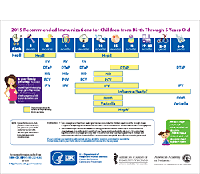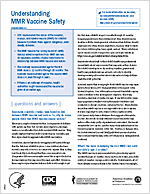Measles, Mumps, and Rubella (MMR) Vaccine Safety
Measles, Mumps, and Rubella Diseases and How to Protect Against Them
Measles causes fever, rash, cough, runny nose, and red, watery eyes. Complications can include ear infection, diarrhea, pneumonia, brain damage, and death.
Mumps causes fever, headache, muscle aches, tiredness, loss of appetite, and swollen salivary glands. Complications can include swelling of the testicles or ovaries, deafness, inflammation of the brain and/or tissue covering the brain and spinal cord (encephalitis/meningitis) and, rarely, death.
Rubella, causes fever, sore throat, rash, headache, and red, itchy eyes. If a woman gets rubella while she is pregnant, she could have a miscarriage or her baby could be born with serious birth defects.
You can protect against these diseases with safe, effective vaccination.
MMR Vaccine Side Effects
The MMR vaccine is very safe, and it is effective at preventing measles, mumps, and rubella. Vaccines, like any medicine, can have side effects. Most people who get MMR vaccine do not have any serious problems with it. Getting MMR vaccine is much safer than getting measles, mumps or rubella.
Common Side Effects of MMR Vaccine
- Sore arm from the shot
- Fever
- Mild rash
- Temporary pain and stiffness in the joints, mostly in teenage or adult women who did not already have immunity to the rubella component of the vaccine
MMR vaccine has been linked with a very small risk of febrile seizures (seizures or jerking caused by fever). Febrile seizures following MMR are rare and are not associated with any long-term effects. Because the risk of febrile seizures increases as infants get older, it is recommended that they get vaccinated as soon as recommended.
Some people may experience swelling in the cheeks or neck. MMR vaccine rarely causes a temporary low platelet count, which can cause a bleeding disorder that usually goes away without treatment and is not life threatening.
Extremely rarely, a person may have a serious allergic reaction to MMR vaccine. Anyone who has ever had a life-threatening allergic reaction to the antibiotic neomycin, or any other component of MMR vaccine, should not get the vaccine.
Available MMR Vaccine
There is one MMR vaccine approved for use in the United States.
- M-M-R II [PDF – 94 KB]: The Food and Drug Administration (FDA) approved this vaccine in 1971 for use in people 12 months of age and older.
The measles, mumps, rubella, and varicella (MMRV) vaccine also protects against these diseases.
How CDC Monitors MMR Vaccine Safety
CDC and FDA continuously monitor the safety of vaccines after they are approved. If a problem is found with a vaccine, CDC and FDA will inform health officials, health care providers, and the public.
CDC uses three systems to monitor vaccine safety:
- The Vaccine Adverse Event Reporting System (VAERS): an early warning system that helps CDC and FDA monitor problems following vaccination. Anyone can report possible vaccine side effects to VAERS.
- The Vaccine Safety Datalink (VSD): a collaboration between CDC and nine health care organizations which allows ongoing monitoring and proactive searches of vaccine-related data.
- The Clinical Immunization Safety Assessment (CISA) Project: a partnership between CDC and several medical centers that conducts clinical research on vaccine-associated health risks.
A Closer Look at the Safety Data
- Two recent studies (Rowhani-Rahbar et al, 2013; Klein et al, 2010) indicate that for every 10,000 children who get their first MMR and varicella vaccines as separate shots when they are 12-23 months old, about four will have a febrile seizure during the 7-10 days following vaccination. Children of the same age who get the combined measles, mumps, rubella and varicella (MMRV) vaccine as their first vaccine against these diseases are twice as likely to have a febrile seizure during the same time period.
- Studies have shown that for children younger than 7 years old, there is a very small increased risk of febrile seizures approximately 6 to 14 days after MMR vaccination; this happens in about 1 in 3,000 to 4,000 children.
- Joint pain is associated with the rubella portion of MMR vaccine among people who do not have immunity to rubella. Joint pain and temporary arthritis happen more often after MMR vaccination in adults than in children. Women also experience this reaction more often than men. Joint pain or stiffness occurs in up to 1 in 4 of females past puberty who were not previously immune to rubella; their symptoms generally begin 1 to 3 weeks after vaccination, are usually mild and last about 2 days. These symptoms rarely come back.
- Immune thrombocytopenic purpura (ITP) is a disorder that decreases the body’s ability to stop bleeding. It can happen after both natural measles infection as well as after getting the MMR vaccine. However, it is usually not life threating. Treatment may include blood transfusion and medications. The risk of ITP has been shown to be increased in the six weeks following an MMR vaccination, with one study estimating 1 case per 40,000 vaccinated children.
- Measles inclusion body encephalitis, or severe brain swelling caused by the measles virus, is a complication of getting infected with the wild-type measles virus. While rare, this disorder almost always happens in patients with weakened immune systems. The illness usually develops within 1 year after initial measles infection and has a high death rate. There have been three published reports of this complication happening to vaccinated people. In these cases, encephalitis developed between 4 and 9 months after MMR vaccination. In one case, the measles vaccine strain was identified as the cause.
- Some parents might worry that the vaccine causes autism. Signs of autism typically appear around the same time that children are recommended to receive the MMR vaccine. Vaccine safety experts, including experts at CDC and the American Academy of Pediatrics (AAP), agree that MMR vaccine is not responsible for increases in the number of children with autism. Read more about vaccines and autism.
More Resources
- MMR Vaccine Information Statement
- MMR Vaccine: Who Should Not Get Vaccinated
- Two Options for Protecting Your Child Against Measles, Mumps, Rubella, and Varicella
- The MMR Decision Aid from the Australia National Centre for Immunisation Research & Surveillance
- Q&As About the Options for Protecting Your Child Against Measles, Mumps, Rubella, and Varicella
- Fact Sheet for Healthcare Providers: MMR & Varicella Vaccines or MMRV Vaccine – Discussing Options with Parents
- Q&As About Vaccination Options for Preventing Measles, Mumps, Rubella, and Varicella: Questions and Answers for Healthcare Providers
Featured resource: Understanding MMR Vaccine Safety [PDF – 500 KB]
Related Scientific Articles
Baram TZ, Gonzalez-Gomez I, Xie ZD, et al. Subacute sclerosing panencephalitis in an infant: diagnostic role of viral genome analysis. Ann Neurol . 1994;36:103-108.
Barlow WE, Davis RL, Glasser JW, Rhodes PH, Thompson RS, et al. The risk of seizures after receipt of whole-cell pertussis or measles, mumps, and rubella vaccine. N Engl J Med. 2001 Aug 30;345(9):656-61.
Beeler J, Varricchio F, Wise R. Thrombocytopenia after immunization with measles vaccines: Review of the Vaccine Adverse Events Reporting System (1990 to 1994). Pediatr Infect Dis J. 1996;15:88-90.
Bibby AC, Farrell A, Cummins M, Erlewyn-Lajeunesse M. Is MMR immunisation safe in chronic idiopathic thrombocytopenic purpura? Arch Dis Child. 2008 Apr;93(4):354-5.
Bitnun A, Shannon P, Durward A, Rota PA, Bellini WJ, et al. Measles inclusion-body encephalitis caused by the vaccine strain of measles virus. Clin Infect Dis. 1999 Oct;29(4):855-61.
Black S, Shinefield H, Ray P, Lewis E, Chen R, et al. Risk of hospitalization because of aseptic meningitis after measles-mumps-rubella vaccination in one- to two-year-old children: An analysis of the Vaccine Safety Datalink (VSD) Project. Pediatr Infect Dis J. 1997 May;16(5):500-3.
Cooper LZ, Ziring PR, Weiss HJ, Matters BA, Krugman S. Transient arthritis after rubella vaccination. Am J Dis Child. 1969;118:218-225.
Davis RL, Kramarz P, Bohlke K, Thompson RS, Mullooly J, et al. Measles-mumps-rubella and other measles-containing vaccines do not increase the risk for inflammatory bowel disease: A case-control study from the Vaccine Safety Datalink. Arch Pediatr Adolesc Med. 2001 Mar;155(3):354-9.
DeStefano F, Chen RT. Negative association between MMR and autism. [Commentary] Lancet. 1999;353(9169):1987–1988.
Dudgeon JA, Marshall WC, Peckham CS. Rubella vaccine trials in adults and children. Comparison of three attenuated vaccines. Am J Dis Child. 1969 Aug;118(2):237-43.
France EK, Glanz J, Xu S, Hambidge S, Yamasaki K, et al. Risk of immune thrombocytopenic purpura after measles-mumps-rubella immunization in children. Pediatrics. 2008 Mar;121(3):e687-92.
Klein NP, Fireman B, Yih WK, Lewis E, Kulldorff M, Ray P, et al. Measles-mumps-rubella-varicella combination vaccine and the risk of febrile seizures. Pediatrics. 2010 Jul;126(1):e1-8.
Marshall WC, Peckham CS, Darby CP, Dudgeon JA, Hawkins GT. Further studies with rubella vaccines in adults and children. Practitioner. 1971 Nov;207(241):632-8.
Miller E, Waight P, Farrington CP, et al. Idiopathic thrombocytopenic purpura and MMR vaccine. Arch Dis Child. 2001 Mar; 84(3): 227–229.
Mustafa MM, Weitman SD, Winick NJ, et al. Subacute measles encephalitis in the young immunocompromised host: Report of two cases diagnosed by polymerase chain reaction and treated with ribavirin and review of the literature. Clin Infect Dis. 1993 May;16(5):654-60.
Polk BF, Modlin JF, White JA, DeGirolami PC. A controlled comparison of joint reactions among women receiving one of two rubella vaccines. Am J Epidemiol. 1982 Jan;115(1):19-25.
Rowhani-Rahbar A, Fireman B, Lewis E, Nordin J, Naleway A, et al. Effect of age on the risk of Fever and seizures following immunization with measles-containing vaccines in children. JAMA Pediatr. 2013 Dec;167(12):1111-7.
- Page last reviewed: October 27, 2015
- Page last updated: May 4, 2017
- Content source:


 ShareCompartir
ShareCompartir

